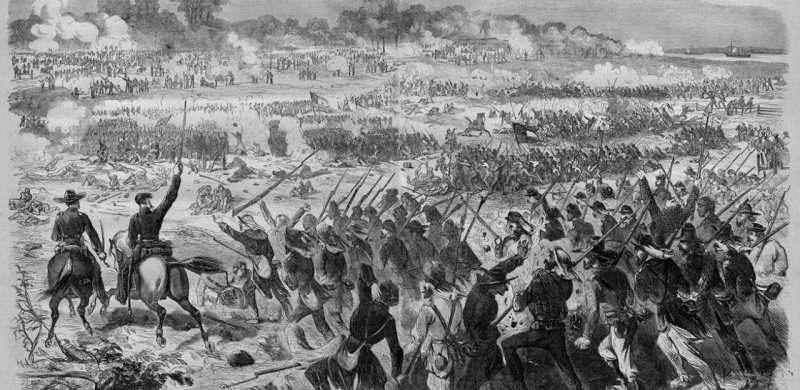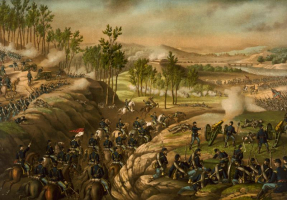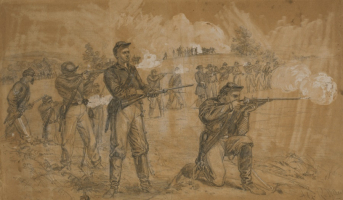Top 7 Facts About The Battle of Malvern Hill
The Battle of Malvern Hills, also known as the Battle of Poindexter's Farm, was fought on July 1, 1862, between the Union Army of Northern Virginia, commanded ... read more...by General Robert E. Lee, and the Union Army of the Potomac under the command of Major. General George B. McClellan. As can be seen, each battle has a great meaning to contribute to human history, let's explore the list of facts about the Battle of Malvern Hill to gain more important insights about this battle.
-
The Seven Days Battles were a series of seven battles over seven days from June 25 to July 1, 1862, near Richmond, Virginia, during the American Civil War. On June 26, 1862, less than a month after taking command of the newly named Army of Northern Virginia, General Robert E. Lee sent troops into the offensive. Over the next week, the Confederate offensive pushed back their blue-clad troops from their strongholds outside Richmond, unraveling General George B. McClellan's plan to capture the Confederate capital. Bloody fighting at places like Beaver Dam Creek, Gaines' Mill, Savage's Station, and on June 30, Glendale changed the tempo and duration of the fighting in Virginia.
At the conclusion of the Seven Days Battles, on the morning of July 1, 1862, Lee's army again threatened the retreating Potomac Army. However, the Yankees held a strong defensive position on a gently sloping terrain just two miles north of the river, known as the Malvern Hills, inviting Lee to attack. The Confederates launched a series of uncoordinated attacks against the well-placed Union artillery. As darkness fell, Lee's men failed to dislodge the Yankees, who had retreated that night. Lee did not pursue; the Seven Days Battle has ended. So, this deserves to be one of the facts about the Battle of Malvern Hill.

Source: civilwarmonitor.com 
Source: essentialcivilwarcurriculum.com -
The Army of the Potomac was the principal Union Army in the Eastern Theater of the American Civil War. It was created in July 1861 shortly after the First Battle of Bull Run and was disbanded in June 1865 following the surrender of the Confederate Army of Northern Virginia in April. Lee's sudden and violent attacks in the last week of June 1862 caught General George B. McClellan completely off guard. Almost immediately, "Little Mac" determined that he could no longer take Richmond, and sent his army into a full retreat toward James. Along the way, elements of the Army of the Potomac stood bravely, trying to slow Lee's advance, but McClellan never deployed the bulk of his army to stop the Rebel attack.
On July 1, 1862, for the first time that week, the Army of the Potomac - all five Union legions were in the same place at the same time. The open nature of Malvern Hill itself allowed the Yankees to deploy their entire massive army in a way they hadn't since the beginning of the seven days. However, elements of the three corps were detailed to protect the Confederate right flank. Even with all his troops in one place, McClellan did not use his entire army. The Army of the Potomac is one of the facts about the Battle of Malvern Hill.

Source: americanhistory.si.edu 
Source: americanhistorycentral.com -
George Brinton McClellan (December 3, 1826 – October 29, 1885) was an American soldier, Civil War Union general, civil engineer, railroad executive, and politician who served as the 24th governor of New Jersey. When McClellan decided to withdraw, the Confederate commander seemed to relinquish all responsibility for managing his troops while they struggled to deal with Lee's relentless advance. He spent most of June 30 aboard the gunboat Galena while the Army of the Potomac averted disaster at Glendale. General McClellan is one of the figures contributing to the success of the list of facts about the Battle of Malvern Hill.
While General McClellan was on the field for most of the Battle of Malvern Hill, his role wasn't much more active than it once was. At dawn on July 1, McClellan met with his favorite subordinate, General Fitz John Porter to discuss the disposition of his troops, before once again retreating to Galena, presumably in preparation for the army's supply base at Harrison's Landing. The commanding general returned to the battlefield afterward but was content to let Porter and his other corps commanders manage the battle on their own. Unlike the previous day's battle, however, McClellan's subordinates had a clear view of the battle plan, and with Porter being the de facto commander of the army, Napoleon the Younger could rest assured that the plan was will be performed.

Source: essentialcivilwarcurriculum.com 
Source: thoughtco.com -
The Confederate artillery, taking advantage of the high ground north of Malvern Hills, Robert E. Lee ordered two "batteries", large artillery batteries, to support the left and right flanks of the army. Lee believed that the fire from these massive cannons would focus on the heart of the Confederacy and weaken the Yankees' ability to fend off the oncoming assault infantry. After a week of hard marching and maneuvering, the new Confederate commander, Robert E. Lee, decided to attack McClellan full-on at Malvern Hill, where the Union general had massed his artillery. His assault was piecemeal, however, and bloodily repelled, prompting Confederate general D. H. Hill to remark that it was not war, it was murder. The Confederate artillery deserves to be one of the facts about the Battle of Malvern Hill.
During the Confederate artillery campaign, unfortunately for the Confederates, logistical problems prevented all but a small part of Lee's artillery from reaching the battlefield, and those guns were put in place. The hot-tempered divisional commander, General Daniel H. Hill, went so far as to call the performance of the Confederate batteries "the weirdest". Confederate artillery - up to 40 cannons concentrated in the center of the Confederacy's position - quickly suppressed the Rebel counterparts. With Confederate guns no longer the primary factor, Yankee gunners turned their attention to the line of gray-clad infantry advancing up the slopes of Malvern Hills, thereby dominating the battle.

Source: encyclopediavirginia.org 
Source: historicalpublicationsllc.com -
The nature of the terrain is described as the elevated plateau known as the Malvern Hills consisting of vast farm fields stretching from the steep slopes of the Malvern Cliffs in the west to the Western Run in the east. Willis Cathedral Road, running roughly north to south, bisected the Confederate position on the hilltop. On the west side of this road, the land rises slightly from the northern part of the field to the top of Malvern Hill, near the Crew's House. Confederate troops on this portion of the battlefield under the command of Benjamin Huger and John Magruder advanced while continuously coming under the Confederate artillery and small arms fire that devastated their ranks.
Regarding the nature of the terrain, the eastern portion of the field, the front of "Stonewall" Jackson, is broken by awkward projections of woodland and steep streams. These features allowed Jackson's men to advance towards the Confederate line out of sight of the Confederate gunners at the top of the hill, but they were also completely cut off from their comrades west of the road. Unable to see - let alone support - each other, Lee's two armies had to fight separately. Therefore, the nature of the terrain is one of the indispensable facts in the list of facts about the Battle of Malvern Hill.

Source: civilwarmonths.com 
Source: civilwarmonths.com -
Colonel Henry J. Hunt's well-placed Confederate artillery dealt a devastating blow to the Confederate infantry, but Lee's troops continued to advance, even gaining effective range to fire their guns. Their muskets and smoothbore pose a danger to Union gunners. As a result, nearby Yankee infantry — such as Charles Griffin's 5th Army brigade or the Irish Brigade — charged forward to dislodge the insurgents and protect their artillerymen from artillery fire. This was especially true at the Stonewall Jackson front, where the terrain allowed Confederates to move out of sight of Confederate artillery. General Darius Couch's blue-shirted infantry division — consisting of a brigade of New Yorkers under General Daniel Sickles — descended the slope to check the advance. Confederate infantry became one of the facts about the Battle of Malvern Hill.
About Confederate infantry, after this bombardment disrupted the Union position, Lee's infantry would attack. Despite repeated attempts, the Confederates failed to mass their guns because of poor communication work by the generals' staff officers and the Confederate practice of deploying batteries with each brigade rather than with the more significant division. Of approximately forty-five Confederate artillery pieces that participated in the fighting, only six to eight did so simultaneously on either flank. The massed Union guns pounded the Confederate batteries and drove them from the field, inflicting about a hundred casualties and killing more than seventy horses. Union gunboats also lobbed shells into the Confederate lines. This challenges the simplistic view of Malvern Hill as merely a battle between Confederate infantry and Confederate artillery. However, as historian Bobby Krick has pointed out, given that Confederate artillery played a minor role in the struggle, it is likely that a large portion of the more than 3,000 Union casualties at Malvern Hill was the outcome of these infantry engagements.

Source: encyclopediavirginia.org 
Source: nps.gov -
The Irish Brigade was an infantry brigade, consisting mainly of Irish Americans, who served in the Union Army in the American Civil War. Since its founding, the Union Army's Irish Brigade received a great deal of attention from the Northern press, largely due to its self-promoting commander, General Thomas Francis Meagher. However, with the exception of a few soldiers who participated in the First Bull Run, most of these Irish soldiers have yet to take any significant action. On July 1, 1862, that began to change. The Irish Brigade is one of the facts about the Battle of Malvern Hill.
Regarding the Irish Brigade, as Confederate attackers drew closer and closer to the Confederate gunners on Malvern Hill, Confederate infantry was dispatched to repel them. Among the units called upon to this task was the Irish Brigade, which rushed into battle late in the day to stop the Confederates' final assaults at Malvern Hills. From that point on, the Irish Brigade began to back up its early war hype with solid performances on the battlefield. They were united under the command of Thomas Francis Meagher, who had been sentenced to death for his part in the failed rebellion of the Young Irishmen of 1848. His sentence was reduced to exile, Meagher. was transferred to Tasmania, where he was able to arrange for an escape to America in 1852.

Source: irishcentral.com 
Source: history.army.mil




























